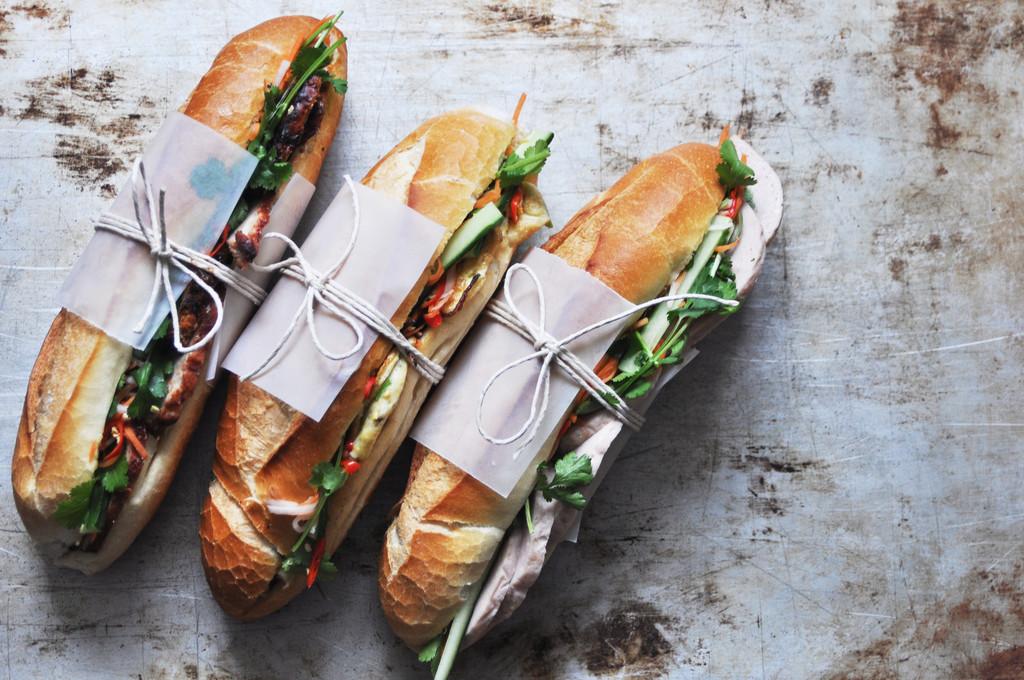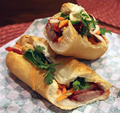
Bánh mì (/ˈbɑːn ˌmiː/ or /ˈbæn ˌmiː/; Vietnamese pronunciation: [ɓǎɲ mî]) is the Vietnamese word for bread. Bread, or more specifically the baguette, was introduced by the French during the colonial period in Vietnam.[6] The bread most commonly found in Vietnamese cuisine is a single-serving baguette that is usually airier than its Western counterpart, with a thinner crust. Unlike the traditional French baguette, the Vietnamese baguette is made with rice flour along with wheat flour (see rice bread).
In Vietnamese cuisine, bánh mì is typically made into a sandwich known as bánh mì kẹp or bánh mì Sài Gòn, eaten alongside dishes such as bò kho (a beef stew) and phá lấu, or dipped in condensed milk. In the Western Hemisphere, especially in areas with substantial Vietnamese expatriate communities, the term bánh mì is used as a synecdoche for the sandwich, which is sold in Vietnamese bakeries.
The word bánh mì is derived from bánh (which can refer to many kinds of food, including bread) and mì (wheat). It may also be spelled bánh mỳ in northern Vietnam. Taken alone, bánh mì means “bread” but is understood to be the Vietnamese baguette. It may also refer to a sandwich (bánh mì kẹp being a more specific word), particularly the sandwiches made on Vietnamese baguettes. These sandwiches are called bánh mì Sài Gòn after the city in which they were popularized. However, even in Vietnam, “a bánh mì for breakfast” implies a meat-filled sandwich for breakfast, not just bread




It is a product of French colonialism in Indochina, combining ingredients from the French (baguettes, pâté, jalapeño, and mayonnaise) with native Vietnamese ingredients, such as coriander, cucumber, and pickled carrots and daikon. By the 1950s, it was sold in its modern form by street vendors in Vietnam. Vietnamese communities in France began selling it in the 1950s as well.
After the Fall of Saigon in 1975, Vietnamese Americans brought bánh mì sandwiches to cities across the United States, where it was sometimes likened to local sandwiches. In New Orleans, a Vietnamese sandwich is sometimes known as a “Vietnamese po’ boy”. For example, a bánh mì recipe won the 2009 award for best po’ boy at the city’s annual po’ boy festival. A restaurant in Philadelphia also sells a similar sandwich, marketed as a “Vietnamese hoagie”. In Northern California, Lê Văn Bá and his sons are credited with popularizing bánh mì among Vietnamese and non-Vietnamese Americans alike through their food truck services provider and their fast food chain, Lee’s Sandwiches, beginning in the 1980s.
Banh mi was added to the Oxford English Dictionary on 24 March 2011
Banh mi can be served as any meals during the day. It all starts with a very light, fresh, crispy and not overly dense Viet style French baguette. Inside the baguette are layers of tasty fillings and accompaniments. Enthusiastically adopted by new audiences, Banh mi can be made with various fillings, prepared in numerous ways, ranging from sour, spicy, salty and sweet in term of flavors. Depending on customer’s needs, the seller will offer many different types. Some common and traditional Banh my fillings are paté, mainly chicken or pig liver paté; fried egg; pork floss; pork roll; cured pork cold cut. In between layers of paté, eggs, pork floss, etc. are fresh herbs, namely cilantro, basil; shredded pickled carrots and green papaya; cucumber slices and a touch of gravy or soy sauce. Stretching from North to South, Banh mi filling diversifies regionally. Besides the traditional fillings, banh mi can be packed with siu mai (in Da Lat), grilled chopped fish (in Nha Trang), fries (in Hanoi) or instead of using normal baguette, people in Hai Phong city have their own “banh mi que” in the shape of a big flat chopstick. In generally, banh mi que includes pate, pork floss, cilantro and is spicy. Compare to traditional Banh mi, Banh mi que is much cheaper and is quite popular as a snack.
With it reputation, Banh mi is considered to be the essence of Vietnamese cuisine. It is a must-try that even the pickiest eater can’t resist.
Address:
- Tây Hồ district:
- Bonbon Bami 61 An Dương, Yên Phu ( Highly Recommended)
- Hoàn Kiếm district:
- Bánh mì Nguyên Sinh: 19 Lý Quốc Sư
- Bánh mì Phố cổ: 38 Đinh Liệt
- Bánh mì Trâm: 30 Đình Ngang
- Bami Bread: 98 Hàng Bạc, 55 Hàng Điếu, 66B Quán Sứ, 102C Trần Hưng Đạo
- Bánh mì Doner Kebab Anh Nguyên: 2 Hàng Bạc
- Bánh mì P: 12 Hàng Buồm
- Bánh mì P: 2E Quang Trung
- Bánh mì nem khoai: opposite 47 Lý Thường Kiệt
- Hai Bà Trưng district:
- Bánh mì phố Huế: 118 phố Huế
- Bánh mì Bít tết Ngọc Hiếu: 22 Hòa Mã
- Ba Đình district:
- Bánhmì: 1 Điện Biên Phủ
Let explore Hanoi food with Hanoi Street Food Tour
In addition, To enjoy the most beautiful sightseeings in Vietnam by your eyes, you can see some itineraries below Halong Bay Cruises – Hanoi Tour – Vietnam Tours – Sapa Tours – Package Tours or book a private car to discover where ever you want to enjoy the Vietnamese taste.
